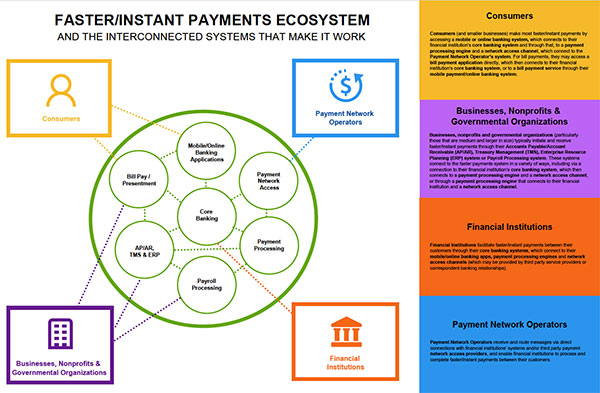It takes an ecosystem: how faster/instant payments go mainstream
In July 2017, the Faster Payments Task Force called for the United States to create a faster, safer, more efficient payment system.1 While the United States has made significant strides in this direction, the challenge still lies in upgrading the many systems and processes that will enable Americans to benefit fully from instant and other forms of faster payments. And as the task force noted, this will be possible only through collaboration among all stakeholders.
So who are these stakeholders? The list includes faster/instant payments solution operators, financial institutions and other payment service providers, businesses, consumers and others – it takes a lot of individuals and organizations playing a variety of interconnected, interdependent roles to work together as a supportive “ecosystem.” Read on to learn more about these players and the roles they play.
The ecosystem: primary roles

There are three primary roles in the U.S. faster/instant payments ecosystem. The first is the role of end users namely, those who make and receive payments, including individuals, businesses, nonprofit organizations, government entities and others. Their desire to take advantage of the benefits of instant and other forms of faster payments will motivate the other participants in the ecosystem.
The second is the role of financial institutions. They provide instant and other types of faster payments services to their end-user customers, which, in many cases, will require making the necessary upgrades to their systems and processes. They include all sizes of banks, credit unions and savings banks, as well as brokerage firms and other organizations that offer financial services.2
The third primary role is that of the interbank network operators. These are the organizations that operate the central clearing and/or settlement arrangements that enable participating financial institutions to complete faster/instant payment transactions. They also determine the service level and technical requirements to participate in their network. They include Zelle®, The Clearing House’s RTP® network, Visa Direct, Mastercard SendTM and eventually the FedNowSM Service.
The ecosystem: supporting roles
While the primary roles are essential, so are the supporting roles of the service providers, which make the ecosystem function effectively. Their services are varied and include support for payments initiation and transactions processing, accounting and recordkeeping, fraud monitoring and prevention, identity management and verification and mobile/online service delivery. As an example, one specific type of service provider includes processors, corporate credit unions and bankers’ banks that support smaller financial institutions with multiple functions such as payment network access, payment processing and customer accounting.
As a group, service providers provide the connective tissue between financial institutions and their customers, and/or between financial institutions and the network operators. As such, updating service providers’ platforms or developing and promoting new, innovative fintech solutions to facilitate faster/instant payments is key to financial institutions’ and end users’ ability to take advantage of the benefits of instant and other faster payments.
Examples of supporting services include:3
- Core banking systems that process and post daily banking transactions to customer accounts and other records at financial institutions, including deposit, loan and credit processing and interfaces to general ledger systems.
- Payment network connectivity services that increase cost effectiveness and efficiency associated with connecting to a new network.
- Payment platforms and/or payment hubs that enable financial institutions to initiate payments, process transactions, easily integrate their core banking system with payment network(s), and may enable payment message format validation, fraud/Anti-Money Laundering checks, etc.
- Mobile app and online banking platform software solutions that enable financial institutions to offer their customers access to account information and the ability to conduct transactions remotely via a mobile device or personal computer.
- Accounts payable/accounts receivable, Treasury Management and Enterprise Resource Planning (ERP) systems that enable businesses to manage payables, receivables and other financial operations.
- Payroll processing systems that enable businesses to manage/automate the processes involved in paying employees and filing employee-related taxes.
- Point-of-sale systems that enable businesses to accept a variety of payments at the point of sale and update accounting records.
- Bill pay/presentment services that enable individuals and/or businesses to initiate payments to billers from an online interface, and billers to present bills electronically to customers, often through an embedded feature of an online banking platform.
Collaboration among all of these interconnected stakeholders – in both primary and supporting roles – is needed to continue progressing toward a faster, safer and more efficient payment system in the United States.
Want to learn more? Check out our instant payments education page for additional topics, or learn about the FedNow Service and latest happenings.
Footnotes
2 This article defines financial institutions as organizations that provide a regulated financial service, such as taking deposits, making payments, lending money, transmitting money, and/or brokering securities transactions.
3 Source: Gartner Magic Quadrant for Retail Core Banking (Off-site).